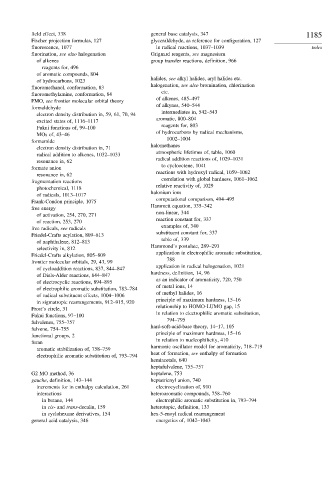Page 1198 - Advanced Organic Chemistry Part A - Structure and Mechanisms, 5th ed (2007) - Carey _ Sundberg
P. 1198
field effect, 338 general base catalysis, 347 1185
Fischer projection formulas, 127 glyceraldehyde, as reference for configuration, 127
fluorescence, 1077 in radical reactions, 1037–1039 Index
fluorination, see also halogenation Grignard reagents, see magnesium
of alkenes group transfer reactions, definition, 966
reagents for, 496
of aromatic compounds, 804
halides, see alkyl halides, aryl halides etc.
of hydrocarbons, 1023
halogenation, see also bromination, chlorination
fluoromethanol, conformation, 83
etc.
fluoromethylamine, conformation, 84
of alkenes, 485–497
FMO, see frontier molecular orbital theory
of alkynes, 540–544
formaldehyde
intermediates in, 542–543
electron density distribution in, 59, 61, 70, 94
aromatic, 800–804
excited states of, 1116–1117
reagents for, 803
Fukui functions of, 99–100
of hydrocarbons by radical mechanisms,
MOs of, 43–46
1002–1004
formamide
halomethanes
electron density distribution in, 71
atmospheric lifetimes of, table, 1060
radical addition to alkenes, 1032–1033
radical addition reactions of, 1029–1031
resonance in, 62
to cyclooctene, 1041
formate anion
reactions with hydroxyl radical, 1059–1062
resonance in, 62
correlation with global hardness, 1061–1062
fragmentation reactions
relative reactivity of, 1029
photochemical, 1118
halonium ions
of radicals, 1013–1017
computational comparison, 494–495
Frank-Condon principle, 1075
Hammett equation, 335–342
free energy
non-linear, 344
of activation, 254, 270, 271
reaction constant for, 337
of reaction, 253, 270
examples of, 340
free radicals, see radicals
substituent constant for, 337
Friedel-Crafts acylation, 809–813
table of, 339
of naphthalene, 812–813
Hammond’s postulate, 289–293
selectivity in, 812
application in electrophilic aromatic substitution,
Friedel-Crafts alkylation, 805–809
788
frontier molecular orbitals, 29, 43, 99
application in radical halogenation, 1021
of cycloaddition reactions, 837, 844–847
hardness, definition, 14, 96
of Diels-Alder reactions, 844–847
as an indicator of aromaticity, 720, 750
of electrocyclic reactions, 894–895
of metal ions, 14
of electrophilic aromatic substitution, 783–784
of methyl halides, 16
of radical substituent effects, 1004–1006
principle of maximum hardness, 15–16
in sigmatropic rearrangements, 912–915, 920
relationship to HOMO-LUMO gap, 15
Frost’s circle, 31
in relation to electrophilic aromatic substitution,
Fukui functions, 97–100
794–795
fulvalenes, 755–757
hard-soft-acid-base theory, 14–17, 105
fulvene, 754–755
principle of maximum hardness, 15–16
functional groups, 2
in relation to nucleophilicity, 410
furan
harmonic oscillator model for aromaticity, 718–719
aromatic stabilization of, 758–759
heat of formation, see enthalpy of formation
electrophilic aromatic substitution of, 793–794
hemiacetals, 640
heptafulvalene, 755–757
G2 MO method, 36 heptalene, 753
gauche, definition, 143–144 heptatrienyl anion, 740
increments for in enthalpy calculation, 261 electrocyclization of, 910
interactions heteroaromatic compounds, 758–760
in butane, 144 electrophilic aromatic substitution in, 793–794
in cis- and trans-decalin, 159 heterotopic, definition, 133
in cyclohexane derivatives, 154 hex-5-enoyl radical rearrangement
general acid catalysis, 346 energetics of, 1042–1043

